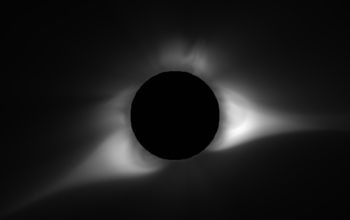Multimedia Gallery
Computer simulations preview solar eclipse (Image 1)
This image shows a version of the predicted brightness of polarized white light in the sun's corona during the solar eclipse on Aug. 21, 2017. The image represents the polarized brightness on a log scale, sharpened using an "unsharp mask" filter. The image is aligned to replicate the view of an observer on Earth with a camera pointed toward the Earth's north pole. [Image 1 of 3 related images. See Image 2.]
More about this image
The Aug. 21, 2017, total eclipse of the sun offered researchers the opportunity to gain a better understand of the sun including further information about its structure -- its inner workings and the space weather it generates.
In advance of the event, on July 28, 2017, a research team from San Diego-based Predictive Science Inc. (PSI) began a large-scale simulation of the sun's surface in preparation for a prediction of what the solar corona -- the aura of plasma that surrounds the sun and extends millions of kilometers into space -- would look like during the eclipse. The project was supported in part by the National Science Foundation.
"The solar eclipse allows us to see levels of the solar corona not possible even with the most powerful telescopes and spacecraft," said Niall Gaffney, a former Hubble scientist and director of Data Intensive Computing at the Texas Advanced Computing Center (TACC). "It also gives high-performance computing researchers who model high energy plasmas the unique ability to test our understanding of magnetohydrodynamics at a scale and environment not possible anywhere else."
The team used massive supercomputers including Stampede2 at TACC, Comet at the San Diego Supercomputer Center (SDSC), and NASA's Pleiades supercomputer to complete a series highly-detailed solar simulations timed to the moment of the eclipse.
"Advanced computational resources are crucial to developing detailed physical models of the solar corona and solar wind," says Jon Linker, president and senior research scientist of PSI. "The growth in the power of these resources in recent years has fueled an increase in not only the resolution of these models, but the sophistication of the way the models treat the underlying physical processes as well."
To learn more about this research, see the TACC news story Spoiler alert: Computer simulations provide preview of solar eclipse. (Date image taken: August 2017; date originally posted to NSF Multimedia Gallery: Aug. 8, 2017)
Credit: Predictive Science Inc.
Images and other media in the National Science Foundation Multimedia Gallery are available for use in print and electronic material by NSF employees, members of the media, university staff, teachers and the general public. All media in the gallery are intended for personal, educational and nonprofit/non-commercial use only.
Images credited to the National Science Foundation, a federal agency, are in the public domain. The images were created by employees of the United States Government as part of their official duties or prepared by contractors as "works for hire" for NSF. You may freely use NSF-credited images and, at your discretion, credit NSF with a "Courtesy: National Science Foundation" notation.
Additional information about general usage can be found in Conditions.
Also Available:
Download the high-resolution JPG version of the image. (79.7 KB)
Use your mouse to right-click (Mac users may need to Ctrl-click) the link above and choose the option that will save the file or target to your computer.



